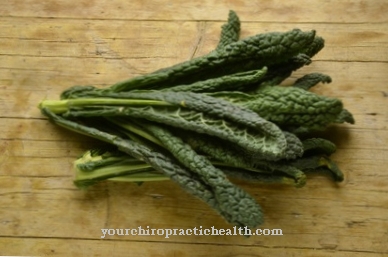Of the Black winter radish is closely related to the white radish, but it has a sharper taste and is only available in the winter months. The winter radish is an old vegetable that is very popular in Asia and is celebrating its comeback in Germany. The black radish mostly comes from organic farming.
What you should know about the black winter radish

The black winter radish (Raphani sativi radix) is also among the names Field radish, Red radish, Long black Parisian radish or just as Black radish or as Winter radish known. It has a slightly hotter taste than its white relative, as it has a higher proportion of mustard oils. While its firm pulp is also white, the skin of the black winter radish is - as the name suggests - dark brown to black. This color is given to it by the scab that covers the skin.
The black radish has the shape of a turnip, which can be round or oblong depending on the variety. Round beets are up to ten centimeters thick and about eight centimeters long. Elongated beets, on the other hand, reach a length of 18 to 25 centimeters with a diameter of up to seven centimeters. Under particularly favorable conditions, a beet can weigh up to 500 grams, and on average a winter radish weighs 300 grams. From a botanical point of view, the black winter radish belongs to the cruciferous family, just like other hot vegetables such as radishes or horseradish. It is an annual plant that flowers purple in color. It is not only cultivated in Europe, but also in China and parts of the USA. It originally comes from the eastern Mediterranean.
The black winter radish was already cultivated about 4000 years ago, among others by the ancient Egyptians. The black winter radish is a very old vegetable variety with a long tradition, but after a phase of almost complete oblivion in the middle of the 20th century, it is gradually being rediscovered. The black radish mostly comes from organic farming.
The main season of the black winter radish begins before the first frost, around October or November. It is sown in July or August, as the growth phase lasts around three to four months. Over the winter, the black winter radish comes from domestic stocks until the white radish is in season again in spring.
Importance to health
The black winter radish contains numerous valuable vitamins and minerals. Its vitamin C content is particularly remarkable, which has an antioxidant effect on the body and supports the immune system. The black radish is also rich in secondary plant substances.
If a radish is to be used for health purposes, the black winter radish is particularly recommended as it has the most active ingredients. To get to this, the juice from the beet is boiled down to a syrup together with sugar.
In addition to essential oils, the black winter radish also contains sulphurous mustard oils, which not only give it its spiciness, but also have an expectorant effect on the body. This is why the black winter radish is often used in naturopathy as a remedy for coughs and other, even stubborn respiratory diseases.
The mustard oils also have a positive effect on digestion and can help with stomach pain as a result of digestive disorders or flatulence. Said mustard oils stimulate the body's own production of bile juices, which can help break down edible fats.
Ingredients & nutritional values
100 grams of raw black winter radish contain the following nutritional values and ingredients on average:
- 18kcal (75kJ)
- 1.1g protein
- 2.4g carbohydrates
- 0.2g fat
- 1.2g of fiber
- 0.03mg vitamin B1
- 0.03 mg vitamin B2
- 0.06mg vitamin B6
- 27mg of vitamin C.
- 41mg calcium
- 0.8mg iron
- 450mg potassium
- 19mg magnesium
- 0.3mg zinc
Intolerances & allergies
The black winter radish can potentially cause food allergies. The symptoms can be external and manifest as redness or itching. Internal symptoms can also arise in the case of radish intolerance after consuming the radish. Typical are abdominal pain, a feeling of fullness, nausea, diarrhea or a feeling of pressure in the upper abdomen.
Shopping & kitchen tips
The black winter radish is only available in the winter months from October and mostly only in organic markets or at the weekly market.From spring it will be replaced on the shelves by its bright relative, the white radish.
Since the black winter radish is very insensitive to pressure due to its robust shell, it can be stored for a long time without any problems. Cleaned and laid in sand, it can stay fresh for up to six months in a cellar. The leaves should be removed beforehand, however, as they wilt and spoil much faster than the beet itself.
The peel of the black radish can generally be eaten. An odor test reveals whether it is still edible. Only when the peel reminds of the smell of mold should it be removed with a peeler or knife. The pulp may still be edible.
Preparation tips
The black winter radish can be eaten raw or cooked. Raw, however, it is seldom used pure than donated in salads. Lovers also like to enjoy it raw with bread and beer. It is mainly cooked in soups, but sometimes also popular as a vegetable side dish. Winter radish loses some of its heat when cooked.
Raw, adding a little salt can partially neutralize the spiciness of the black winter radish. Long contact with the air or soaking in water or vinegar also makes the taste of the black radish milder.
The black winter radish is particularly popular in Asian cuisine. In Japanese cuisine, the black winter radish is often served in small quantities as a decorative accompaniment to sushi and other dishes. To do this, the radish is cut into wafer-thin slices with a sharp knife, which are often artfully draped. In this small amount, the sharpness is usually desired and is not neutralized.
















.jpg)
.jpg)



.jpg)





